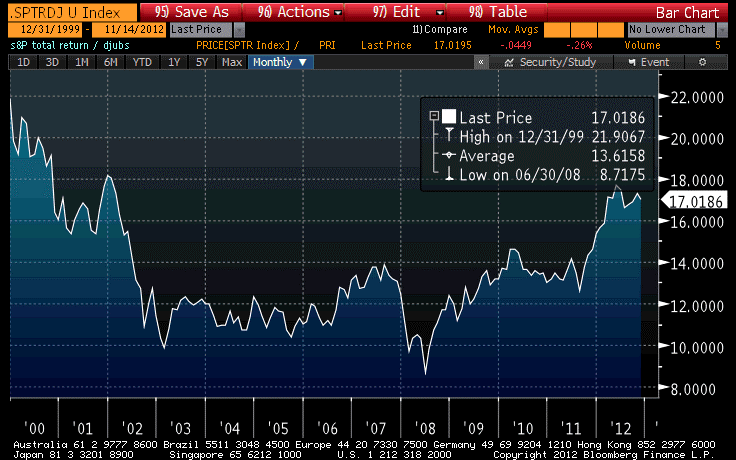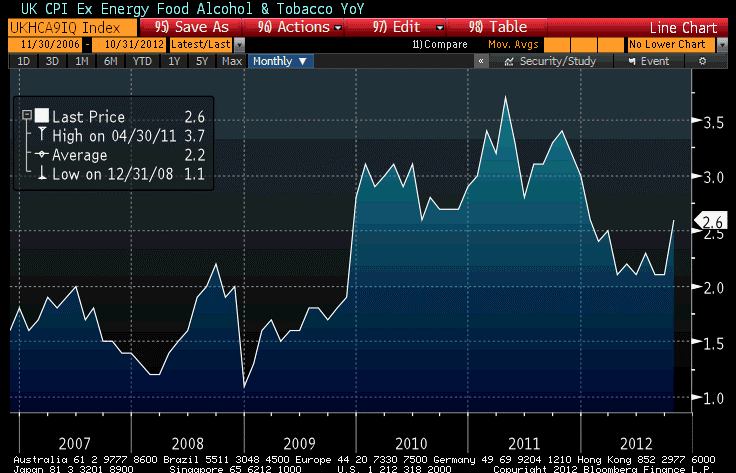Whether it is that the passage of the U.S. election released Europe to begin fighting amongst themselves again about Greece, or instead that they’ve been fighting the whole time and we just didn’t notice because we were so introspective, it’s certainly happening and heating up again. The Eurozone finance ministers are bickering, publicly, over whether Greece should be given two more years to hit its financial targets. (See articles here and here.)
Also, and more importantly, the IMF wants the government owners of Greek bonds to write off some of their losses and lessen the Greek burden while some of the finance ministers (e.g., German Finance Minister Schauble) insist “that’s not legally possible.” Guess what? It’s going to happen whether it’s legally possible or not – but not this month. Greece will probably eventually get its tranche/lifeline this month, but the battle will be engaged with increasing intensity as time goes on.
That, however, is not the reason why stocks keep sliding (S&P -1.4% yesterday) and bonds keep rallying (albeit gently yesterday, with the 10y note yield down to 1.59%). I think that is happening because one week post-election, there is no sign that either Democrats or Republicans are budging on their positions vis a vis the fiscal cliff. The Democrats are winning on messaging, as they usually do these days, with the “Papa John’s Pizza approach” in which they have seized on the part of Romney’s budget proposal that they liked (reducing deductions for high-income taxpayers) while ignoring the connection of that element with the intention to keep tax rates down. I call it the Papa John’s Pizza approach because it reminds me of the commercial with Peyton Manning.
Republicans: So how are we going to do this?
Democrats: We loved Romney’s idea, and we agree with you. We’ll cut deductions.
Republicans: No, no, no, no, no…you mean we’ll cut deductions and keep income tax rates from rising.
Democrats: Right. We’ll cut deductions.
Republicans: …you mean we’ll cut deductions and keep rates from rising.
Democrats: I’m glad we agree. We’ll cut deductions. See how open minded we are? We’re using Romney’s plan!
Say what you want about the class warfare approach, the Democrats run rings around the Republicans when it comes to communication.
One place where better communication is actually destructive, but ironically one of the only places where we’re actually moving towards better communication, is at the Federal Reserve. A Wall Street Journal article yesterday was entitled “Fed Leans Toward Clearer Guidance,” and indicated that “the Fed would state how high inflation would have to rise or how low unemployment would have to fall before it would begin moving rates, which have been near zero since late 2008.” This was the main newsworthy point that Fed Vice-Chair Janet Yellen made Tuesday, and it was driven home yesterday in the release of the minutes from the October Fed Meeting:
“A number of participants questioned the effectiveness of continuing to use a calendar date to provide forward guidance….Many participants thought that more-effective forward guidance could be provided by specifying numerical thresholds for labor market and inflation indicators.”
Since June, a “soft” Evans Rule based on this idea has been in place, as I pointed out at the time. It is not terribly surprising that the Fed would move towards a more explicit formulation of the rule, because Fed economists have never figured out why ambiguity is a good thing when it comes to policy-making. If they really do manage to reduce the Fed’s deliberations to a series of simple and public rules, then they should just finish the job and replace the Fed with a computer, as Milton Friedman proposed many years ago.
As I’ve written frequently (and borderline obsessively), clarifying the exact path that the Federal Reserve will take in the future reduces the uncertainty that investors face. This is good in the absence of leverage, but if the opportunity to leverage exists then the decrease of apparent uncertainty causes an increase in the leverage desired by investors. The problem is that a margin of safety doesn’t only protect an investor from known uncertainties, which would decrease in this instance, but also from unknown uncertainties, which would not be affected and for which a margin of safety is absolutely crucial if we desire to avoid another financial market meltdown. But no one is listening to me.
Commodities rose yesterday, despite the continued decline in equities. This is not unreasonable. I think that commodities and stocks are telling two different stories. If there’s a recession, it should hurt stocks and commodities (but more directly should hurt stocks) while further QE3 ought to help them (but more directly help commodities). Right now stocks are going up on QE3 while commodities are going down on the recession … exactly the opposite of what ought to be happening. To my mind that just means the ‘value gulf’ is getting wider and wider.
The chart below (Source: Bloomberg) shows the ratio of the S&P total return index to the DJ-UBS index. 
Right now there is an enormous loathing for commodities that I don’t really understand – it seems to me to be the bipolar nature of commodities investors that they either love or hate the stuff. It probably comes from the fact that there are no “value” investors in commodities since the theory on what constitutes “value” is so light. Right now it looks to me like stocks are relatively expensive, although they’ve been that way for a while.
For today’s CPI figures, the consensus forecast calls for an 0.1% rise month/month for both the headline and core indices (seasonally adjusted), maintaining the y/y core increase at 2.0%. Last month, core rose to 1.98%, and we’re ‘dropping off’ a +0.17% on the y/y comparison. If economists are right, and 0.1% is the rounded change in core inflation on the month, then the y/y rise in core inflation will more likely decline to +1.9% than stay at +2.0% (of the possible prints that would lead to +0.1% on the monthly, from +0.05% to +0.149%, anything from +0.05% to +0.129% would cause a downtick in the y/y figure while only monthly changes in the range of +0.130% to +0.149% would keep the number stable.
However, I don’t see what will cause core to droop like that. I think economists are paying too much attention to the last several monthly changes and ignoring the fact that the weak prints were caused by outlier points (as evidenced by the fact that the Median CPI of the Cleveland Fed and the Sticky CPI of the Atlanta Fed, both different measures of central tendency, remain at +2.3% and +2.2% respectively).
Moreover, housing CPI – the main driver of core inflation – is accelerating with both primary rents and owner’s equivalent rent rising last month, and all indicators of housing tightness from housing inventories to apartment tightness continue to suggest that higher price increases are more likely than lower price increases ahead. Moreover, we’re seeing upside surprises in other countries, such as in Greece that I mentioned Tuesday, in the UK where core inflation rose to +2.6% y/y versus 2.2% expected (see Chart, Source Bloomberg), befuddling most economists there.
That doesn’t mean the y/y core figure in the U.S. will definitely rise back to +2.1% this month; to do that, core would need to print +0.23% for the month, meaning the main body of the economist profession was off by half.
Come to think of it, that’s not so far-fetched. If the last three months of core prints (+0.090%, +0.052%, and +0.146%) are quirky-low, then there should be a payback at some point. It’s hard to call for that in any given month, though.
- English (UK)
- English (India)
- English (Canada)
- English (Australia)
- English (South Africa)
- English (Philippines)
- English (Nigeria)
- Deutsch
- Español (España)
- Español (México)
- Français
- Italiano
- Nederlands
- Português (Portugal)
- Polski
- Português (Brasil)
- Русский
- Türkçe
- العربية
- Ελληνικά
- Svenska
- Suomi
- עברית
- 日本語
- 한국어
- 简体中文
- 繁體中文
- Bahasa Indonesia
- Bahasa Melayu
- ไทย
- Tiếng Việt
- हिंदी
Commodities And Stocks Telling Two Different Stories
Published 11/14/2012, 11:31 PM
Updated 02/22/2024, 09:00 AM
Commodities And Stocks Telling Two Different Stories
3rd party Ad. Not an offer or recommendation by Investing.com. See disclosure here or
remove ads
.
Latest comments
Install Our App
Risk Disclosure: Trading in financial instruments and/or cryptocurrencies involves high risks including the risk of losing some, or all, of your investment amount, and may not be suitable for all investors. Prices of cryptocurrencies are extremely volatile and may be affected by external factors such as financial, regulatory or political events. Trading on margin increases the financial risks.
Before deciding to trade in financial instrument or cryptocurrencies you should be fully informed of the risks and costs associated with trading the financial markets, carefully consider your investment objectives, level of experience, and risk appetite, and seek professional advice where needed.
Fusion Media would like to remind you that the data contained in this website is not necessarily real-time nor accurate. The data and prices on the website are not necessarily provided by any market or exchange, but may be provided by market makers, and so prices may not be accurate and may differ from the actual price at any given market, meaning prices are indicative and not appropriate for trading purposes. Fusion Media and any provider of the data contained in this website will not accept liability for any loss or damage as a result of your trading, or your reliance on the information contained within this website.
It is prohibited to use, store, reproduce, display, modify, transmit or distribute the data contained in this website without the explicit prior written permission of Fusion Media and/or the data provider. All intellectual property rights are reserved by the providers and/or the exchange providing the data contained in this website.
Fusion Media may be compensated by the advertisers that appear on the website, based on your interaction with the advertisements or advertisers.
Before deciding to trade in financial instrument or cryptocurrencies you should be fully informed of the risks and costs associated with trading the financial markets, carefully consider your investment objectives, level of experience, and risk appetite, and seek professional advice where needed.
Fusion Media would like to remind you that the data contained in this website is not necessarily real-time nor accurate. The data and prices on the website are not necessarily provided by any market or exchange, but may be provided by market makers, and so prices may not be accurate and may differ from the actual price at any given market, meaning prices are indicative and not appropriate for trading purposes. Fusion Media and any provider of the data contained in this website will not accept liability for any loss or damage as a result of your trading, or your reliance on the information contained within this website.
It is prohibited to use, store, reproduce, display, modify, transmit or distribute the data contained in this website without the explicit prior written permission of Fusion Media and/or the data provider. All intellectual property rights are reserved by the providers and/or the exchange providing the data contained in this website.
Fusion Media may be compensated by the advertisers that appear on the website, based on your interaction with the advertisements or advertisers.
© 2007-2024 - Fusion Media Limited. All Rights Reserved.
